'Superstition swallows everything and examines
nothing.': Tacitus.
Thanks to dosseman: Osseman for his
critically important
photos:
https://pbase.com/dosseman/root.
Introduction
Turkey has a number of classical looking theaters attributed to various ancient Greek individuals or cities. However, these attributions are incorrect. A few of these structures were repaired by people in the historic-time-frame (HTF), but most, having suffered destruction ranging from severe to total, remained unused. The ruins have very interesting stories to tell, but no one is listening. All were built before the Pleistocene Catastrophe (PC). The period when Mega Fauna and large majority of mankind were swept away. It could also be called the Great Technology Reset (GTR) when the PC returned man to the Stone Age. Modern man still can not duplicate with equivalent efficiency Antecedent technology of quarrying, shaping and moving stone. Theirs was a plasma and not electrical based technology. These theaters suffered destruction only plasma could have inflicted.
Block weight is a central assertion of this site. Blocks found at many ruins were too large for people in the HTF to use efficiently. A cubic foot of limestone weights 169 lbs1. So to move a foot of rock, a small block, required a minimum of two men and doubling the size, four. Romans built the famous Pont du Gard aqueduct with blocks, but they did not build anymore like it [Wikipedia]. Using blocks was very expensive. Ease of use determined the size and type of building material. That is why Romans were brick and concrete people. Plasma's property of levitation allowed Antecedents to easily manipulate large blocks and raise monumental structures. Without plasma technology, research becomes a black hole swallowing facts and returning nothing.
Selge Theater
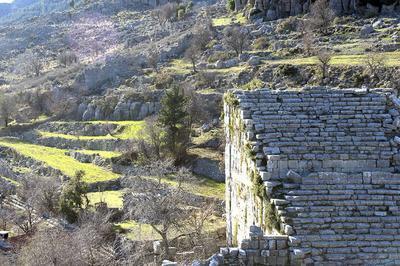
The above image shows both the perpetrator and victim. In the background are zp-prints defined by AEC formed when plasma from a z-pinch and earth connected. Buildings existing around the theater were erased by the these connections. Arable land was left in the connection's wake. A zp-print comes right up to the theater's base, fig.2. Since the it curls around the theater, there is a probable connection between AEC and theater's damage.
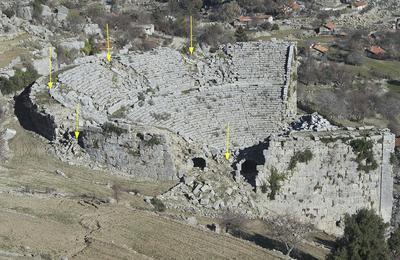
Sardinians apparently were the only group to build structures as shelters from the ZPA. In the image above, the zp-print curls around the theater's mass. While the plasma could slice open a large building, it could not do the same to the theater's massive structure. This observation must have been made by the Sardinians. As a result they built large nuraghi like Santu Antine as a defense.
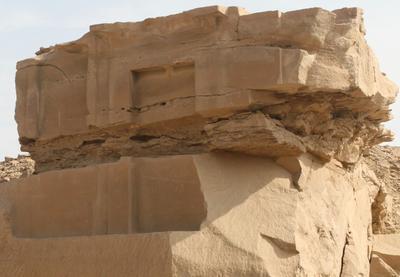
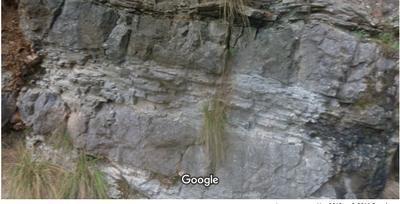
Figure 3: c. irie: Images from a previous articles. dosseman:'s fig.2 image probably explains these two showing plasma's path through rock, and what is occurring to create the Osseman slump (see below). Also explained is why columns survive plasma events better than stone walls. Plasma needed a solid as a conductor. Once it entered earth's surface, plasma's path switched from vertical to horizontal. It was the major architect of the terrain surface and probably a lot more.
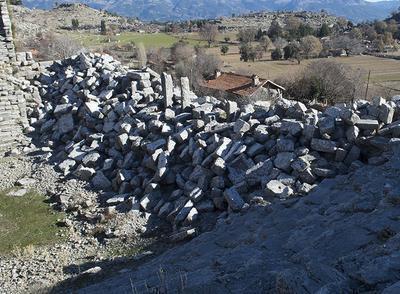
A Greek theater was a semicircle of seats around the orchestra (arena) with a structure behind called a skene. It housed items needed for productions. The skene at Selge is a heap of blocks, fig.4. Palmyra showed columns survive plasma storms much better than solid block walls. Since the columns were eroded, fig.5, the lowest level blocks must have been severely eroded. They loss their dimensional integrity and gave way as earth's gravity reasserted itself. If the building come down hard, columns would have been carried away too. Therefore, the blocks settled gently into a heap.


Tlos Theater

In the above image, plasma cut gaps in the Tlos theater's back wall (arrows) and sliced through the skene. Blocks, fig.7, originally lying along the edge of the orchestra and up the seats have been cleaned up. Thanks to Dick Osseman, the image was captured before conservators inflicted the damage. Position of blocks are directly related to gravity's presence at the terminal phase of the ZPA appearance. At times levitation was not minor. Granite boulders from Norway have been found on Scottish beaches.
Plasma environments differ not in behavior but only in degree. Some are strong events like what wrecked Palmyra, and some are weaker like what struck the Tlos Theater, but they perform in like manner. The weaker ZPAs did not have the power to etch zp-prints on the landscape like those around Selge theater. Each may be composed of many plasma currents connecting earth to the ZPA. Between currents, energy is not so great. Evidence for this are the three gaps (arrows) cut through the back wall of the Tlos Theater above. This would explain how Antecedent buildings like the Temples of Bacchus/Jupiter and Niha (not shown) were sliced open. Like the 'Jekyll and Hide' arch seen in the Palmyra article, currents operated like a knife slicing up stone.
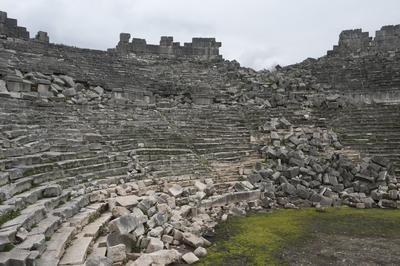
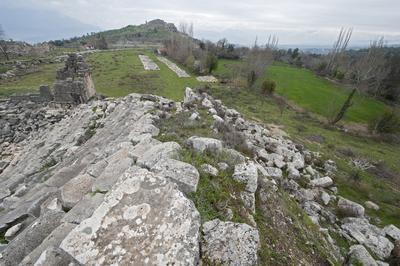
The Tlos theater should be surrounded by an extensive field of ruins. As can be seen in the above image, that is not the case. Theaters were built in urban areas midst human activities. The missing structures once occupying the fields were planed off by Peratt Events. They cut through the middle of urban areas where plasma connection were made between earth and ZPA. The same will occur to a modern city if the z-pinches are not broken up. It will take real science to develop that technology.
Stratonicea Theater
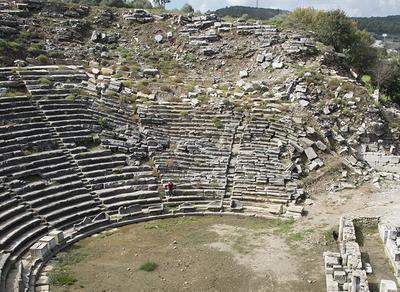

The above two images are very important in understanding plasma's behavior. Note how the seating has slumped in fig.9. Fig.10 is the same area showing slump from different angle. This indicates plasma does not work from top down like a laser, but works in three dimensions, penetrating to a given depth transforming soil simultaneously along the length of penetration. Fig.3 sustains this assertion. The volume of soil or rock under the seats was reduced so the surface settled. This feature is seen on the landscape in the form of smooth surface undulations. It is going to be termed an Osseman slump (OS). The OS is far more common than AEC which is the result of a Peratt event; it also might purge small stones from soil. Rolling landscapes seen everywhere are the result of OS.
Magarsus Theater
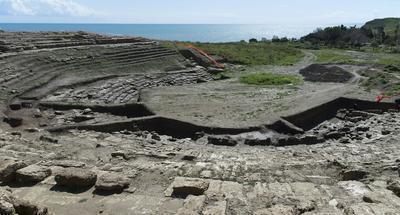
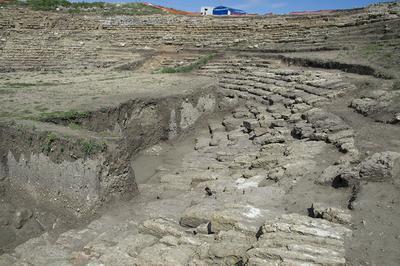
The above two images sustain the assertion made on this site that soil has its origin in plasma events. Ten to twelve thousand years ago, a ZPA deposited colluvium on the theater2. If Dick Osseman had not taken this picture before the orchestra was 'cleaned up', this material would have remained unknown. All of Sardinia's nuraghi were buried to some extent, and that material was cleared away without the slightest thought it might be related to building of these structures3. The accumulation of colluvium in the orchestra may be related to the theaters shape since Letoon and probably others contain it. In fig.11 colluvium extended into the seats (diazoma) but not decisively so which is contrary to expectations. Z-pinches have been knocking humans around for millions of years. The capacity to develop technology ameliorating their appearance is available today, but nothing be done while science wallows in shamanism.
Xanthos Theater
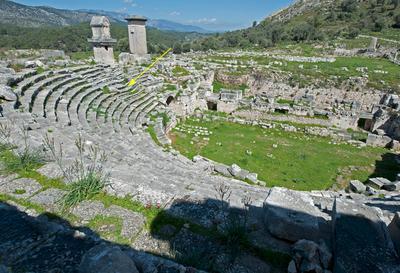
AnL had been through ZPA storms before. This is reflected in the use of dovetails to knit blocks together. Another indicator was at the Karnak Cachette where bronze statuettes were found buried 15 to 16 meters. They were aware of plasma's destructive effect on metal even underground. Therefore, the anecdote was to bury metal objects deeply. The depth also might indicate AnL were aware a serious event was heading their way. A corona mass ejection would have taken 60-70 hours to reach earth. Digging a large deep pit was not an activity quickly accomplished so prompt action was required.
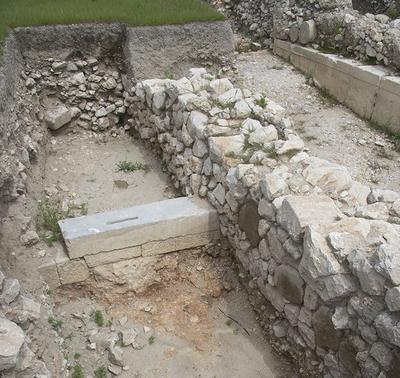
The image above indicated what happened at Xanthos. Evidence from Egypt and Engineer Creek in Alaska shows at least three major terrain altering plasma events occurred. Top of the image is a layer of coarse colluvium overlain by a very fine layer. The layers probably reflected events intensities. What deposited the coarse material was much weaker than that depositing the top layer. AnL survived the first appearance to some extent. The field stones used for wall construction reflect this. The second event ended AnL civilization. The survivors probably withdrew to other areas salvaging their religion, writing and some knowledge but not their technology. They lost the capacity and technical knowledge to generate power. Without energy their equipment was useless and therefore broken up for its metal content.
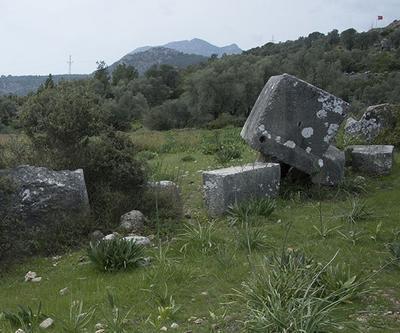
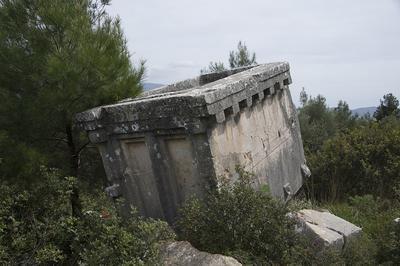
Figure 16: dosseman: Cockeyed position of these vaults exemplify the levitating effects of ZPA when they passed over. Cut from a single block of stone, they weighed thousands of pounds.
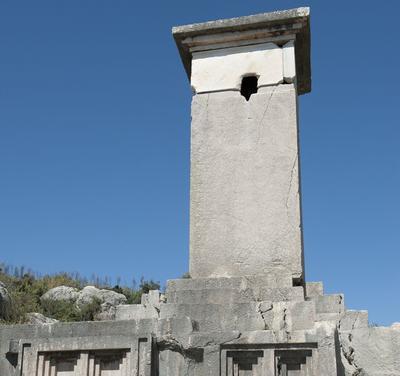
Patara Theater
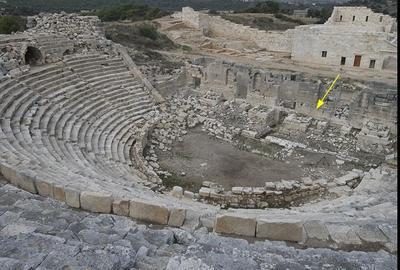
Patara has the usual destruction found at all other theaters. It was cleaned up somewhat in 2002-4. The level of colluvium deposition can be determined by the line of lighter coloration on the blocks, see arrows in fig.18,19. The theater has not been used since the GTR. Once again Dick Osseman recorded a critically important image in fig.20. It shows a framed Greek text carefully chiseled into the blocks. No one in the HTF stepped over all the wreckage to carve on the blocks a probable attribution or dedication. It was done by Antecedent Greeks. Like Egyptian hieroglyphic writing, Greek language extends back well beyond the GTR.4 An obvious conclusion is classical architecture did originate with the Greeks only they were Antecedent Greeks. The question is raised which side of the Aegean Sea was Greece's ancestral home?

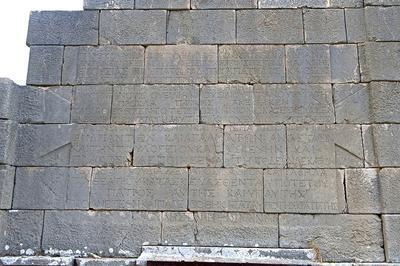
Witnessing events over the previous tens of thousands of years that left evidence like the above images must have motivated Antecedents to pursue the science of plasma. But, they were unprepared for the scale of destruction that occurred with the GTR. Boulders created by events in Norway were deposited on east coast Scottish beaches. These cobbles are very distinctive5. Only a very powerful appearance of ZPA could have carried these stones between the two countries.
Finding Norwegian boulders on Scottish beaches sustains another point raised on this site. Great distances were covered as z-pinches moved across the landscape. Pleistocene animals were driven in front of them. These animal either died of exhaustion or en masse when they reached a landscape that terminated further movement. That was how 800 bison died at the Bonfire Shelter near Langtry, Tx. when terrain stopped further progress. Bone bed 2 returned three C14 dates spanning 310 years6; a range very close to G. L. Gidding's 307 year span for the shredded forests at Engineer Creek, Alaska7. Survivors probably faced famine given destruction to landscape, wildlife and economic infrastructure then a slow rebuilding lasting 8,000 years.
The Osseman Collection8 of photos make very clear Antecedent civilizations were wealthy and robust with extensive literary culture. Just as Egyptian religion and writing never died out, the same happened in Levantine areas. However, their accomplishments are shrouded in a web of fantasy narratives. Research has become a contortionist exercise in shaping facts to match the nonsense. It is absurd to think some researchers do not see the hollowness of narratives. Yet, none have raised a warning flag that something is profoundly wrong. Research narratives are nothing less than propaganda wholly detached from reality. It is a threat to the Republic. A day will come when tomorrow will be catastrophically different from yesterday. The z-pinches are coming back.
https://www.aqua-calc.com/calculate/volume-to-weight↩︎
The Letoon Theater also has a thick layer of colluvium in the orchestra and can be seen here: https://pbase.com/dosseman/letoontheatre.↩︎
The age of Sardinia's nuraghi has never been determined. Given the amount of colluvium encasing them, they probably were built after the first appearance of the ZPA during the PC 10-12,000 years ago. Apparently Sardinian culture was the only one to build structures specifically to counter the ZPA threat. Most common response was to dig tunnels, such as the extensive tunneling in Europe.↩︎
Most languages are equally ancient.↩︎
An image can be seen here: https://www.sandatlas.org/rhomb-porphyry/↩︎
https://www.utep.edu/leb/PleistNM/sites/bonfireshelter.htm↩︎
See Death of the Mega Fauna article↩︎
dosseman: Osseman is owed an immense debt of gratitude for compiling thousands of images of ancient sites not found anywhere else.↩︎

